- Clone
- D7 (See other available formats)
- Regulatory Status
- RUO
- Other Names
- Sca-1
- Isotype
- Rat IgG2a, κ
- Ave. Rating
- Submit a Review
- Product Citations
- publications
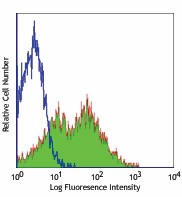
-

C57BL/6 mouse splenocytes stained with D7 FITC
| Cat # | Size | Price | Quantity Check Availability | Save | ||
|---|---|---|---|---|---|---|
| 108105 | 50 µg | £49 | ||||
| 108106 | 500 µg | £201 | ||||
Ly-6A/E, also known as Sca-1, is an 18 kD member of the Ly-6 multigene family. Ly6A/E is a glycosylphosphatidylinositol (GPI)-linked protein expressed on hematopoietic stem cells. In mice expressing the Ly-6.2 haplotype (e.g., AKR, C57BL, C57BR, DBA/2, SJL, SWR, and 129), Ly-6A/E is also expressed on peripheral B lymphocytes and thymic and peripheral T lymphocytes. Strains expressing the Ly-6.1 haplotype (e.g., BALB/c, CBA, C3H/He, DBA/1, and NZB) have low Ly-6A/E expression on resting peripheral lymphocytes. The expression of Ly-6A/E on lymphocytes is upregulated upon activation from both Ly6.1 and Ly6.2 haplotype mice. Ly-6A/E is thought to be involved in the regulation of both T and B cell responses.
Product DetailsProduct Details
- Verified Reactivity
- Mouse
- Antibody Type
- Monoclonal
- Host Species
- Rat
- Immunogen
- IL-2-dependent mouse T-cell line (CTL-L)
- Formulation
- Phosphate-buffered solution, pH 7.2, containing 0.09% sodium azide.
- Preparation
- The antibody was purified by affinity chromatography, and conjugated with FITC under optimal conditions.
- Concentration
- 0.5 mg/ml
- Storage & Handling
- The antibody solution should be stored undiluted between 2°C and 8°C, and protected from prolonged exposure to light. Do not freeze.
- Application
-
FC - Quality tested
- Recommended Usage
-
Each lot of this antibody is quality control tested by immunofluorescent staining with flow cytometric analysis. For flow cytometric staining, the suggested use of this reagent is ≤1.0 µg per million cells in 100 µl volume. It is recommended that the reagent be titrated for optimal performance for each application.
- Excitation Laser
-
Blue Laser (488 nm)
- Application Notes
-
The D7 antibody has been reported to induce T cell activation and inhibit TCR-induced IL-2 production. Additional reported applications (for the relevant formats) include: Western blotting1,2, immunoprecipitation1, in vitro lymphocyte activation3-6, induction of redirected lysis7, induction of T cell inhibitory signalling8, immunofluorescence9, and immunohistochemical staining of acetone-fixed frozen sections13 and Bouin-fixed, paraffin-embedded samples9.
The two Sca-1 recognizing clones D7 and E13-161.7 have been shown to bind distinct epitopes due to the inability of D7 to block the binding of E13-161.7.14 -
Application References
(PubMed link indicates BioLegend citation) -
- Ortega G, et al. 1986. J. Immunol. 137:3240. (WB, IP)
- Palfree RGE, et al. 1986. Immunogenetics 23:197. (WB)
- Codias EK, et al. 1990. J. Immunol. 144:2197.
- Malek TR, et al. 1986. J. Exp. Med. 164:709.
- Codias EK, et al. 1990. J. Immunol. 145:1407.
- Ivanov V, et al. 1994. J. Immunol. 153:2394.
- Karlhofer FM, et al. 1991. J. Immunol. 146:3662.
- Fleming T, et al. 1994. J. Immunol. 153:1955.
- van Bragt MPA, et al. 2005. Biol. Reprod. 73:634. (IF, IHC)
- Umland O, et al. 2007. J. Immunol. 178:4147.
- Cridland SO, et al. 2009. Blood Cell. Mol. Dis. 45:149. (FC) PubMed
- Pronk CJ, et al. 2011. J. Exp Med. PubMed
- English A, et al. 2000. J. Immunol. 165:3763. (IHC)
- Bamezai A and Rock KL. 1995. Proc. Natl. Acad. Sci. USA 92:4294.
- Wiesner DL, et al. 2015. PLoS Pathog. 11:1004701. PubMed
- Product Citations
-
- RRID
-
AB_313342 (BioLegend Cat. No. 108105)
AB_313342 (BioLegend Cat. No. 108106)
Antigen Details
- Structure
- Ly-6 multigene family, 18 kD
- Distribution
-
Hematopoietic stem cells, activated T cells and B cells, subset of resting B cells and T cells
- Function
- Regulates B and T cell responses
- Cell Type
- B cells, Hematopoietic stem and progenitors, Mesenchymal Stem Cells, T cells
- Biology Area
- Immunology, Stem Cells
- Antigen References
-
1. Rock KL, et al. 1989. Immunol. Rev. 111:195.
2. Morrison SJ, et al. 1994. Immunity 1:661.
3. Spangrude GJ, et al. 1988. J. Immunol. 141:3697.
4. Malek T, et al. 1986. J. Exp. Med. 164:709. - Gene ID
- 110454 View all products for this Gene ID
- Specificity (DOES NOT SHOW ON TDS):
- Ly-6A/E
- Specificity Alt (DOES NOT SHOW ON TDS):
- Ly-6A/E
- App Abbreviation (DOES NOT SHOW ON TDS):
- FC
- UniProt
- View information about Ly-6A/E on UniProt.org
Related Pages & Pathways
Pages
Related FAQs
Other Formats
View All Ly-6A/E Reagents Request Custom ConjugationCustomers Also Purchased
Compare Data Across All Formats
This data display is provided for general comparisons between formats.
Your actual data may vary due to variations in samples, target cells, instruments and their settings, staining conditions, and other factors.
If you need assistance with selecting the best format contact our expert technical support team.
-
APC anti-mouse Ly-6A/E (Sca-1)
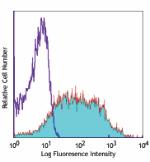
C57BL/6 mouse splenocytes stained with D7 APC -
Biotin anti-mouse Ly-6A/E (Sca-1)
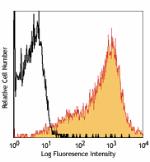
C57BL/6 splenocytes stained with biotinylated D7, followed b... -
FITC anti-mouse Ly-6A/E (Sca-1)
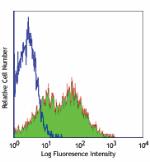
C57BL/6 mouse splenocytes stained with D7 FITC -
PE anti-mouse Ly-6A/E (Sca-1)
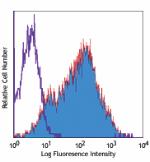
C57BL/6 mouse splenocytes stained with D7 PE -
PE/Cyanine5 anti-mouse Ly-6A/E (Sca-1)
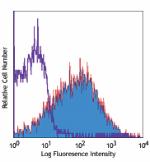
C57BL/6 mouse splenocytes stained with D7 PE/Cyanine5 -
Purified anti-mouse Ly-6A/E (Sca-1)
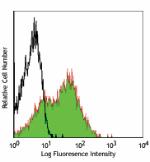
C57BL/6 splenocytes stained with purified D7, followed by an... -
PE/Cyanine7 anti-mouse Ly-6A/E (Sca-1)

C57BL/6 mouse splenocytes stained with D7 PE/Cyanine7 -
Alexa Fluor® 488 anti-mouse Ly-6A/E (Sca-1)
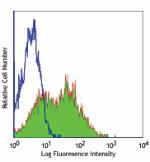
C57BL/6 mouse splenocytes stained with D7 Alexa Fluor® 488 -
Alexa Fluor® 647 anti-mouse Ly-6A/E (Sca-1)
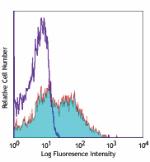
C57BL/6 mouse splenocyteS stained with D7 Alexa Fluor® 647 -
Pacific Blue™ anti-mouse Ly-6A/E (Sca-1)
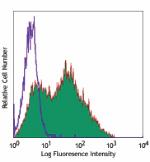
C57BL/6 mouse splenocytes stained with Pacific Blue™ D... -
Brilliant Violet 421™ anti-mouse Ly-6A/E (Sca-1)
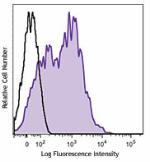
C57BL/6 mouse splenocytes were stained with Ly-6A/E (clone D... 
C57BL/6 mouse bone marrow cells were stained with Ly-6A/E (c... -
PerCP anti-mouse Ly-6A/E (Sca-1)
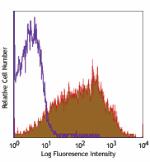
C57BL/6 mouse splenocytes stained with D7 PerCP -
PerCP/Cyanine5.5 anti-mouse Ly-6A/E (Sca-1)

C57BL/6 mouse bone marrow stained with Lineage FITC, CD117 (... -
APC/Cyanine7 anti-mouse Ly-6A/E (Sca-1)
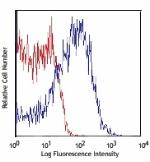
C57BL/6 splenocytes stained with D7 APC/Cyanine7 -
Brilliant Violet 510™ anti-mouse Ly-6A/E (Sca-1)
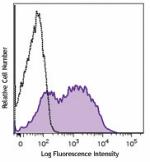
C57BL/6 mouse splenocytes were stained with Ly-6A/E (clone D... 
C57BL/6 mouse bone marrow cells were stained with Ly-6A/E (c... -
Brilliant Violet 711™ anti-mouse Ly-6A/E (Sca-1)

C57BL/6 mouse splenocytes were stained with Ly-6A/E (clone D... -
Brilliant Violet 605™ anti-mouse Ly-6A/E (Sca-1)
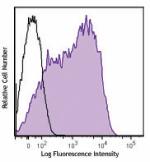
C57BL/6 mouse splenocytes were stained with Ly-6A/E (clone D... -
Purified anti-mouse Ly-6A/E (Sca-1) (Maxpar® Ready)
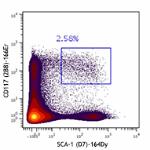
Mouse bone marrow cells stained with 164Dy anti-Sca-1 (D7) a... -
PE/Dazzle™ 594 anti-mouse Ly-6A/E (Sca-1)
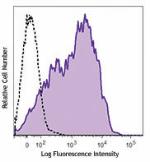
C57BL/6 mouse splenocytes were stained with Ly-6A/E (clone D... -
Brilliant Violet 785™ anti-mouse Ly-6A/E (Sca-1)
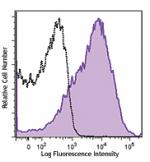
C57BL/6 mouse splenocytes were stained with Ly-6A/E (clone D... 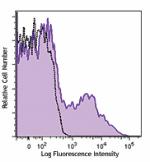
C57BL/6 mouse bone marrow cells were stained with Ly-6A/E (c... -
Alexa Fluor® 700 anti-mouse Ly-6A/E (Sca-1)
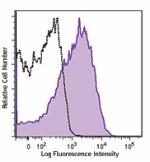
C57BL/6 mouse splenocytes were stained with Ly-6A/E (clone D... 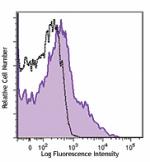
C57BL/6 mouse bone marrow cells were stained with Ly-6A/E (c... -
Brilliant Violet 650™ anti-mouse Ly-6A/E (Sca-1)

C57BL/6 mouse splenocytes were stained with Ly-6A/E (clone D... -
APC/Fire™ 750 anti-mouse Ly-6A/E (Sca-1)
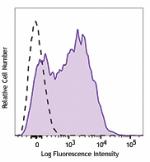
C57BL/6 mouse splenocytes were stained with Ly-6A/E (clone D... -
TotalSeq™-A0130 anti-mouse Ly-6A/E (Sca-1)
-
TotalSeq™-B0130 anti-mouse Ly-6A/E (Sca-1)
-
TotalSeq™-C0130 anti-mouse Ly-6A/E (Sca-1)
-
Spark NIR™ 685 anti-mouse Ly-6A/E (Sca-1)
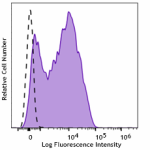
C57BL/6 mouse splenocytes were stained with anti-mouse Ly-6A... -
Spark PLUS UV395™ anti-mouse Ly-6A/E (Sca-1)

C57BL/6 mouse splenocytes were stained with anti-mouse Ly-6A...

 Login / Register
Login / Register 











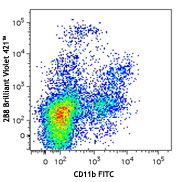
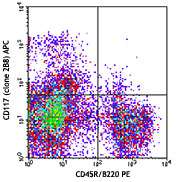



Follow Us